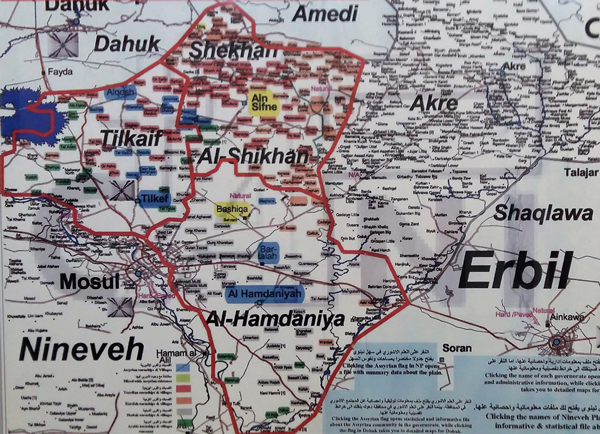For much of its modern history, Iraq has been caught up in sectarianism and conflict, most recently with the rise of the Islamic State (IS). The ethnoreligious heterogeneity of the Nineveh Plains has made it an epicentre of sectarian tensions and disputes. Since the mid-1970s, the Ba’athist Arabization campaigns involved the forced displacement and cultural Arabization of Nineveh Plains’ minorities including village destruction, depopulation and deportation of Kurds and Yazidis. Arabization concentrated on moving Sunni Arabs into the area by, for example, reallocating plots of land to Ba’ath loyalists. Since the overthrow of the Hussein regime in 2003, the region has once more become a bone of contention between the central government in Baghdad and the Kurdistan regional government in Erbil. Post-2003 Kurdification policies by the Kurdistan Democratic Party (KDP) and Patriotic Union of Kurdistan (PUK) have sought to reverse previous attempts at Arabization and to regain control of the Nineveh Plains.[1] This has created serious inter-ethnic problems with non-Kurdish populations. Making an already bad situation much worse, IS mercilessly targeted the Plains’ ethnoreligious non-Sunni minorities, especially indigenous Yazidis, Christians and Turkmen. The extremist organisation sought to wipe out the entire collective memory of these communities, as was evident in the group’s systematic destruction of religious and heritage sites.
After the defeat of IS in 2017, the security situation in the Nineveh Plains gradually improved and today the area is considered largely stable with a low incidence of violence. But as the threat of IS has gone and violence has abated, old vulnerabilities persist while new ones have arisen. Citizens are neglected and communities underserviced in a post-war landscape of dire conditions.[2] Reconstruction remains a huge challenge and efforts to date have given little priority to livelihoods and economic infrastructure. The government is closing camps for internally displaced persons (IDPs) without any coherent policy on how to enable safe returns or support vulnerable communities upon the return of displaced groups. As a result, thousands of families leaving camps have little to return to and therefore either become re-displaced or emigrate. This continues to dramatically shift the area’s demographics and local control to the disadvantage of minorities.
As the respective governments in Baghdad and Erbil are more focused on oil and land disputes elsewhere because of their greater strategic value, the Nineveh Plains have been ignored. Poor governance has produced power vacuums occupied by informal actors and armed groups. Deliberately discriminatory policies of marginalisation and deprivation by political majorities and armed groups have continued to tether the Plains’ agricultural and commercial dynamism since before IS occupation. The combination of conflict prior to IS and the recent fight against it have destroyed much of the area’s social capital. The war and its aftermath, moreover, sowed feelings of anger, betrayal and disillusionment among its communities, which either were ravaged by IS (mostly non-Sunni) or initially gravitated towards it (mostly Sunni) and were subsequently punished. The complete rupture of the pre-2014 status quo due to the war also intensified already pervasive identity issues, which is linked to settlement of the administrative status of disputed territories and the protection of minority groups. As the weight of these issues drags communities down and a government response remains absent, desperation and misery grow.
To inform more positive action from outside the area, this report examines key factors of stability and instability in the Nineveh Plains or, more precisely, in the triangular area between Duhok, Erbil and Mosul composed of the districts of Shekhan, Hamdaniyah and Tel Kaif. Long considered home to Iraq’s many religious and ethnic minorities, this part of the Nineveh governorate represents a micro case study of tensions faced more generally in liberated areas with mixed ethno-sectarian groups.
The report’s key insight is that the current level of human insecurity is likely to breed more frustration, grievance and anger among marginalised communities (even though security levels have improved) and this risks triggering another round of displacement or even violence in the longer term. Avoiding such a scenario requires addressing the triple crisis of political contestation over the area between Baghdad and Erbil, social distrust and division and the prevailing fragmentation of security arrangements.
On the basis of 23 field interviews[3] and extensive desk research, the report analyses four major factors of stability and instability in the area: Section 1 analyses the administrative and governance vacuum; Section 2 surveys the fragmentation of its security arrangements; Section 3 examines chronic displacement; and Section 4 assesses its growing social tensions. Section 5 concludes the report with policy recommendations that should be taken into account when designing or implementing development work in the area.[4]
The Tigris River divides the Nineveh province geographically and demographically. The area to the right of the river, the Nineveh Plains, is estimated to cover about 5,000 square kilometres, and extends in the form of a plain arc surrounding the city of Mosul, from the Hammam al-Alil side in its far east, up towards the Kurdish-majority town of Barada Rush, then heading west towards the town of Farah and reaching the Mosul Dam Lake. This plain includes the districts of Tel Kaif, Hamdaniyah and Shekhan, which were historically populated predominantly by Syriac Christians (mainly Assyrians and Chaldeans). A minority of Shabaks (Sunni and Shiite) inhabited the rural areas of Hamdaniya, and particularly its Bartilla subdistrict. Shekhan district was inhabited mainly by Kurds with a Yezidi majority. While it is difficult to assess the current estimates, it appears that the majority of inhabitants in the Nineveh Plains are currently Shabaks (majority Shia, minority Sunni), followed by the Christian population, the Yezidis, the Kurds, Arab Muslims, the Kaka’is and Turkmen. The strategic location of the Nineveh Plains is significant as the region connects Mosul with both Erbil and Dohuk via highway number two, with four additional internal routes solidifying area connectivity. Furthermore, it includes the key border crossing of Khosrsaband and is believed to connect Iraq to Syria and Lebanon through an informal military transport route.

Source: Nineveh© Provincial Council
